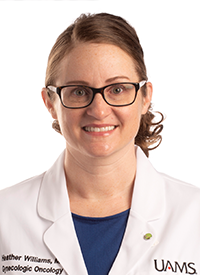ADC Advances and Updated PARP Indications Support Focus on Individualized Approaches in Ovarian Cancer
Heather R. Williams, MD, expands on updated data from the the phase 3 PRIMA trial initially supporting the use of frontline PARP inhibitor maintenance in ovarian cancer, as well as changing indications for niraparib based on data from the NOVA trial.
Heather R. Williams, MD

Changes to the use of PARP inhibitors in platinum-sensitive ovarian cancer, alongside encouraging results with emerging antibody-drug conjugates (ADCs), are not only shifting treatment approaches across ovarian cancer subtypes, but elucidate the need for more effective, tolerable, and targeted treatment options for more heavily pretreated populations, according to Heather R. Williams, MD.
“We know that the majority of patients with ovarian cancer do respond upfront, but the [cancer often] comes back. When it comes back, our options become more and more limited,” Williams explained in an interview with OncLive® regarding her presentation at a recent Institutional Perspectives in Cancer webinar on gynecologic cancers. “We are going to need more targeted therapy that's patient-centered, because not all tumors are created equal.”
Previously reported updated survival data from the phase 3 ENGOT-OV16/NOVA trial (NCT01847274) demonstrated that second-line maintenance niraparib (Zejula) produced a hazard ratio of 1.06 in the non–germline BRCA-mutated cohort (95% CI, 0.81-1.37), and was associated with an increased risk of death. These data led the regulatory agency to restrict niraparib’s second-line maintenance indication to patients with recurrent platinum-sensitive ovarian cancer harboring deleterious or suspected deleterious germline BRCA mutations.
In the interview, Williams expanded on updated data from the phase 3 PRIMA trial (NCT02655016) initially supporting the use of frontline PARP inhibitor maintenance in ovarian cancer, as well as changing indications for niraparib based on data from the NOVA trial. Williams also reported encouraging data with the antibody-drug conjugate (ADC) mirvetuximab soravtansine-gynx (Elahere) and spotlighted several potential targets for future ADC development across gynecologic cancers.
Williams is an assistant professor in the Department of Obstetrics and Gynecology – Division of Gynecologic Oncology, at University of Arkansas for Medical Sciences, Little Rock, Arkansas.
OncLive: How has the use of PARP inhibitors evolved in ovarian cancer?
Williams: The big thing [discussed in my presentation] was the previous indications for niraparib, and highlighting the changes that were made last year. As data have continued to mature, they gave us a different picture of how things were working, which can be the case. That's why we follow these studies out, to ensure that the safety and/or effectiveness is maintained from the initial results.
Could you discuss the updated data in favor of maintenance niraparib in ovarian cancer from the PRIMA trial?
[Findings from the] PRIMA [study] still stand, and niraparib still has its indications based off the results from that study. PRIMA was looking at maintenance [niraparib] following response to platinum therapy in the frontline setting. The interesting thing about PRIMA was that [investigators] accepted BRCA-mutated populations as well as [those who were] BRCA wild type. They further subdivided [patients] by whether there was homologous recombination deficiency [HRD] or proficiency [HRP]. They found that, in comparison with the placebo group, niraparib had a benefit in all the subgroups, even the HRP group. It was a modest benefit of 3.5 to 4 months, but there was still benefit there, and we don't have much else [to use] in that patient population. That was the key difference [between PRIMA] and the other trials of frontline PARP inhibitor maintenance. [PRIMA is] why the FDA indication and approval [was upheld] for [niraparib].
Please expand on updated data from the NOVA trial that led to the FDA withdrawal of niraparib’s treatment indication in the recurrent, platinum-sensitive setting.
The NOVA trial was looking at maintenance [niraparib] following response to platinum [chemotherapy] in the recurrent setting. [This is a] difficult patient population because we don't have very many maintenance options for these patients, and the window of progression-free survival [PFS] or disease-free intervals for these patients, gets shorter and shorter as they go on. Having an option [in this space] for patients is something that we need. The NOVA study broke down [patients into those] with germline mutations versus [those without]. Unlike what we saw in the frontline setting, the benefit that we saw originally in the HRD-positive group wasn't maintained.That did lead to the FDA withdrawal of niraparib for that [indication]. For BRCA-positive patients, the indication still stands. Looking at the data as they matured, there wasn't a benefit there still [in the non–BRCA-mutant group].
Regarding the withdrawal of this treatment indication for niraparib, what might be done to address the need for approved treatments for this heavily pretreated population moving forward?
It proves the point that we need to keep looking at using PARP inhibitors in combination with other medications, or looking at completely different classes of drugs, which was what the second half of my talk was about. [We also need to identify more] biomarkers to determine patient-specific [benefit] and get into the heart of personalized medicine. There's so much we don't know and so many things about these tumors that are unique. There are probably specific medications that can be targeted to these tumors that will work better. Some of those [may] be [effective when administered] in combination with PARP inhibitors as well. I don't think the door is completely closed on PARP, there's [still much] to be learned in the treatment setting.
How can ADCs such as mirvetuximab soravtansine address the need for equally effective yet more tolerable regimens in the platinum-resistant setting?
The [phase 3] SORAYA [NCT04296890] and MIRASOL [NCT04209855] trials have [demonstrated] very good data [regarding] how patients tolerated this [ADC]. These [studies included] heavily pretreated populations, so their bone marrow is not going to hold up. Obviously, these patients have progressive disease, so there are symptoms from the disease itself. When [investigators] looked at the how patients did with [mirvetuximab soravtansine] in MIRASOL, they did better than [those in the] standard chemotherapy arm. We know that chemotherapy is toxic, and [can produce] significant [adverse] effects [AEs] in patients. We try to use the adage that we don't want the treatment to be worse than the disease. While ADCs have their own unique AEs that we as providers have to watch out for and learn about, it seems like patients do reasonably well with them. [The toxicity profile associated with ADCs is] not worse than [that of our] our options right now, [namely] standard chemotherapy.
What treatment-related toxicities are important to note with this agent?
[Mirvetuximab soravtansine is associated with] ocular AEs, [which is] something that we're not used to dealing with. Most patients [experience] some blurriness and are required to [use] eyedrops [a certain number of] times throughout the day. There are very specific instructions from the company, and when [patients are] on trial, about keeping a daily log of when they're putting their eyedrops in. They must be on top of those steroid drops and lubricating drops.
There can [also] be more severe [AEs] like keratopathy. If [patients] see an eye doctor before [treatment, this can be monitored]. We don't usually work with ophthalmologists or optometrists when we're seeing our patients, so that's something new for us to troubleshoot. [Regardless], an eye exam [should be performed] at the forefront. As treatment goes on, [patients should] get another eye exam to make sure that everything is going okay after a couple of treatment cycles.
[Lastly] the education of patients and their caregivers [should be a focus] as well. Patients are smart enough that they can handle it. Other medications in this class have been used in other disease sites with success, and patients are able to manage eye drops and [other management strategies].
Could you briefly spotlight some exciting potential ADC targets in ovarian cancer?
[In my presentation], I discussed [agents targeting] folate receptor alpha [(FRα), which] has gotten the most press. Some [targets] that are up and coming [include] NaPi2b, which is a sodium-[dependent] phosphate transporter. It's exciting to learn about how ADCs work. They take a very potent chemotherapy agent, which we could never give in isolation by itself because it would be too toxic and combine it with this antibody that only allows [the chemotherapy] to be released once it gets into the tumor cell. It's like a little Amazon delivery service: [once] you get what's in the package to where it's supposed to go, it can kill the tumor cell.
This is fascinating technology and science that will [provide] a huge benefit for these patient populations, especially as we learn more about targets on these tumor cells that are not on all the normal cells. [With] targeted therapy, you [can] hopefully avoid all those [off-target] toxicities. [Most of the ADCs in development] are in early phase 1 studies. Some of them don't have drug names. Certainly, there have been other ADCs in other disease sites. We do have approvals in the gynecologic cancer sphere, such as tisotumab vedotin [Tivdak] in cervical cancer. [There's] a lot of exciting targets there. The main targets that are hot [for ADC development] in ovarian cancer right now are NaPi2b and FRα.
What has been seen with upifitamab rilsodotin (XMT-1536; UpRi) in the phase 1 UPGRADE-A (NCT04907968) and phase 3 UP-NEXT trials (NCT05329545)?
The UPGRADE-A trial, which is a phase 1 dose escalation/expansion trial, is ongoing. That is being conducted in the platinum-sensitive space, which is different from [the setting in which] MIRASOL was conducted. This is fascinating, because I do think we have great activity in the platinum-sensitive space, but it's not 100% foolproof. UPGRADE-A is looking to use UpRi [in combination with] with carboplatin followed by maintenance in the platinum-sensitive disease setting. It will be fascinating to see how that goes.
The UP-NEXT trial [is evaluating] post-platinum maintenance in a recurrent, platinum-sensitive [population]. This is a phase 3 study, so a larger cohort of patients will be enrolled. [Investigators are] allowing for 2 to 4 prior lines of therapy, [including prior response to] a platinum therapy. [The study] will be randomized 2:1, so patients will receive UpRi or placebo.
What is your main takeaway message for colleagues based on this presentation?
As treating physicians for gynecologic cancers, we all know that we need more options in this patient population. All these tumors have different profiles, [so we also need to] figure out which drug will be best for which patient. That's where we're headed, and it's exciting to watch it all unfold. Thirty years ago, there was only standard chemotherapy [in ovarian cancer]. [Although] I'm sure that was exciting at the time, [we] now [have] all these ADCs and PARP inhibitors, which haven't been around for that long in the grand scheme of things. It's exciting to be a part of the science that is happening in real time.
Reference
GSK provides an update on Zejula (niraparib) US prescribing information. News release. GlaxoSmithKline. November 11, 2022. Accessed September 5, 2023. https://otp.tools.investis.com/generic/regulatory-story.aspx?cid=410&newsid=1643742



